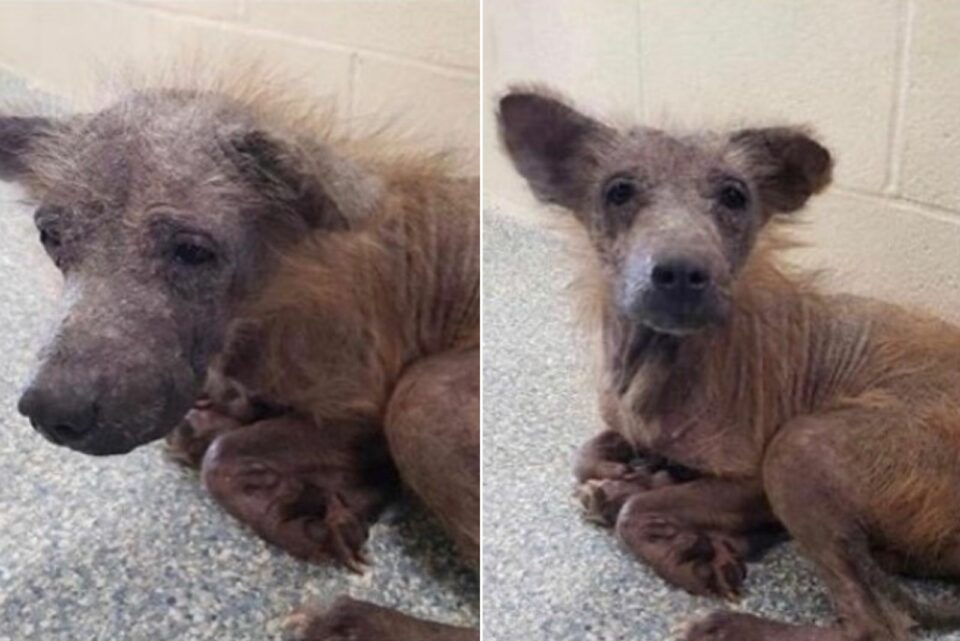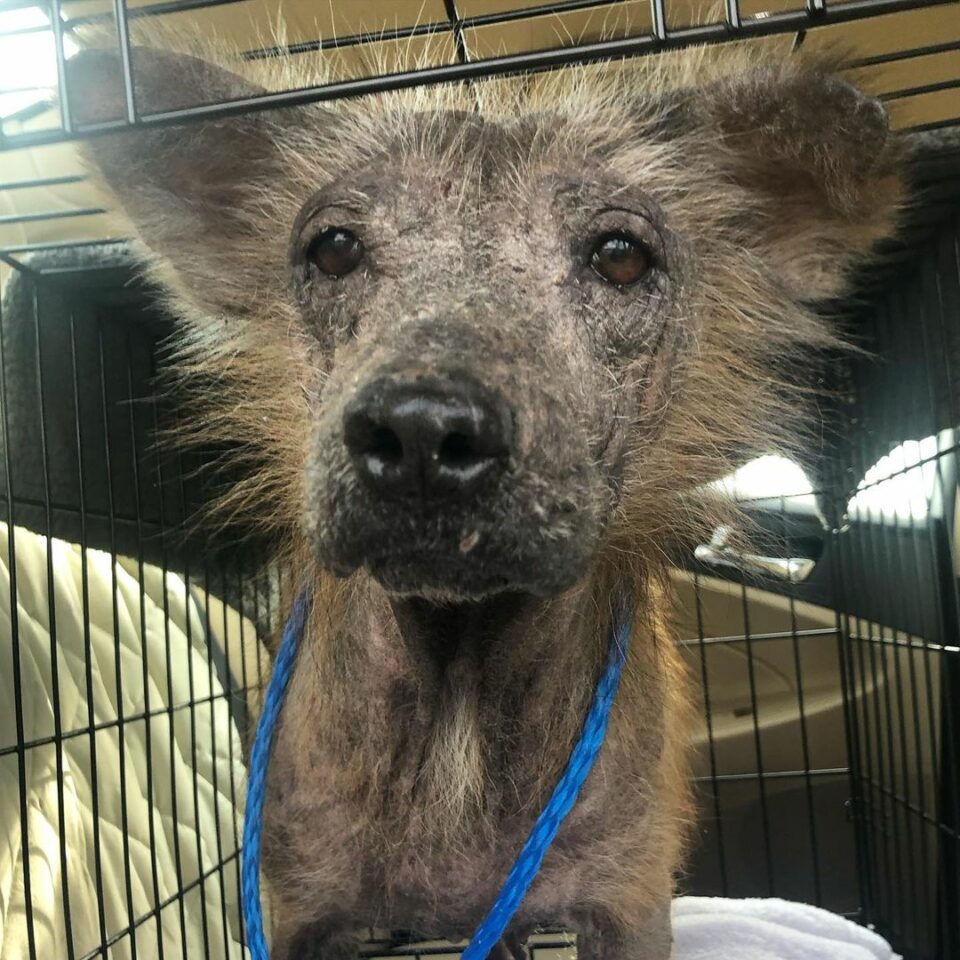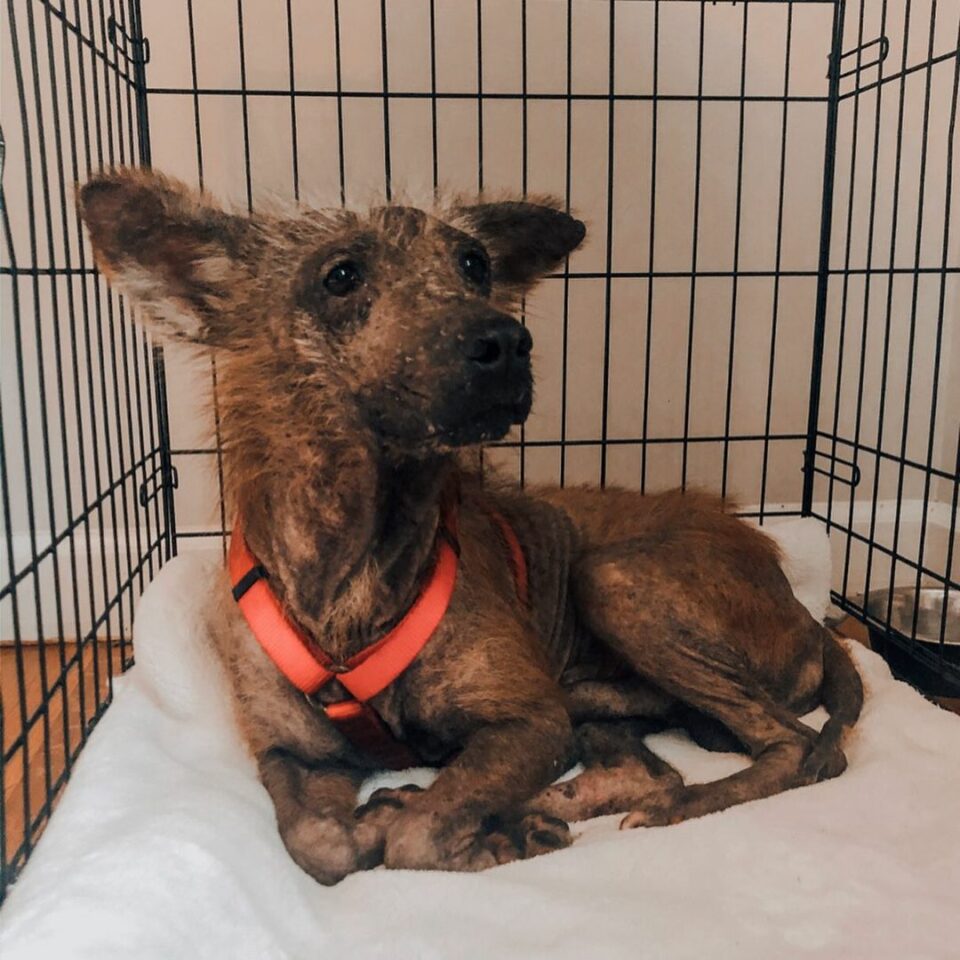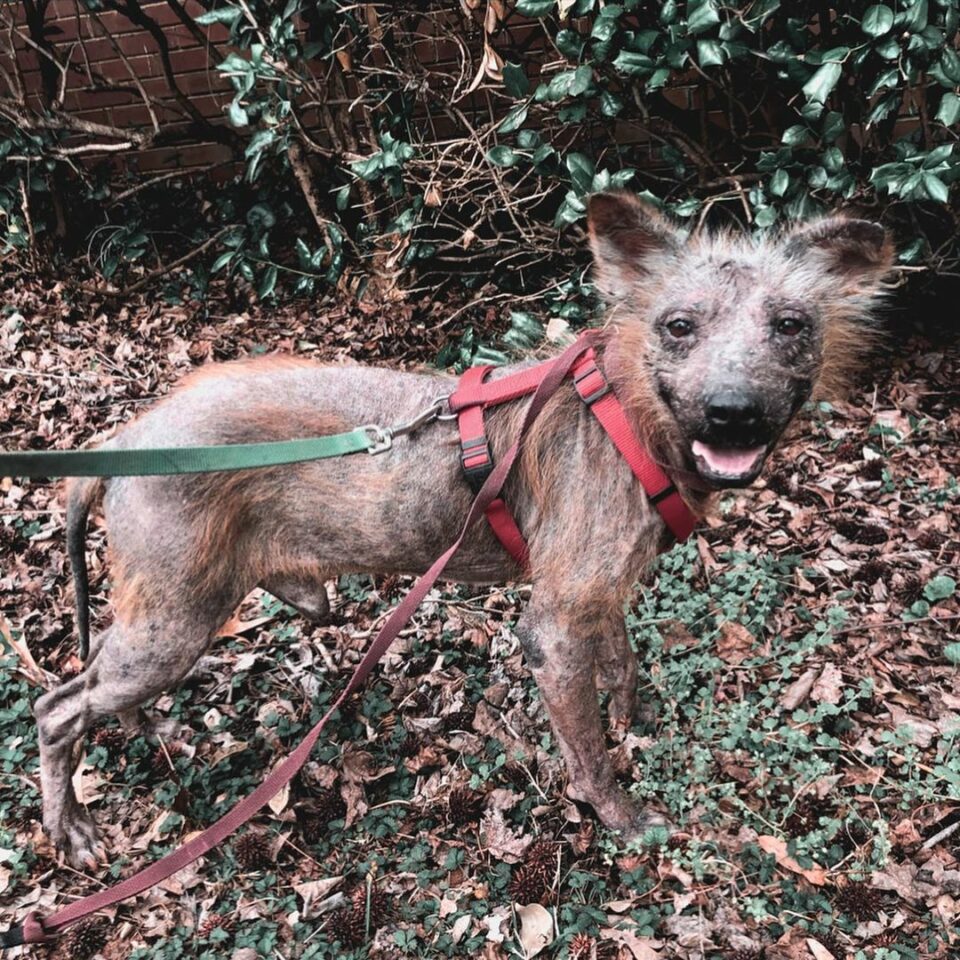Griffin, a little hairless pup with a broken spirit, was one of twenty dogs rescued from a severe case of animal cruelty and neglect in North Carolina.
Shortly after, Angela Marie, a compassionate founder of a rescue and sanctuary, “Angela’s Ark,” in Charlotte, NC, was scrolling through her Facebook when suddenly, Griffin’s face popped up on her feed.
He was sick, hairless, and curled up in a ball on the shelter floor, desperately awaiting better days or someone to come save him.
The desperate look in his eyes prompted Angela to swiftly drive to the shelter where he was and get him out of there.
That marked the beginning of Griffin’s new life…
Griffin’s Journey To Overcoming Trauma

Due to spending the first couple of years of his life in extremely cruel and inhumane conditions, Griffin’s physical health was severely compromised.
He was malnourished, battling several severe skin infections, and suffering from hair loss and an ear infection. Additionally, he required surgery to remove 14 badly infected teeth.
As you can imagine, his mental state wasn’t any better – Griffin was a grumpy, confused, and overall terrified pup with a deeply broken spirit who wanted nothing to do with humans.

The first day at Angela’s home, poor Griffin couldn’t stop shaking from fear. That’s when she realized he was going to be a very complicated case.
“Griff and I have experienced more firsts together than any rescue to date. Basic life skills like walking up and down stairs, wearing a collar, even being touched were foreign to him. For weeks, simple daily routines were a struggle,” Angela wrote in a Facebook post.
Throughout his short life, Griffin had never been handled, nor had he ever experienced the loving touch of a human. His view on humans was deeply flawed due to the abuse he experienced.

The first couple of days at Angela’s Ark were extremely stressful for both Griffin and Angela. She wanted to help, but he was terrified of her.
According to Angela, Griffin was her biggest challenge to date but also the most rewarding one.
While looking after him, she learned to cherish and celebrate every little moment and appreciate even the smallest signs of progress, or “small wins” as she likes to call them.
Finding The Perfect Furever Home

Slowly, Griffin started to relax and venture out of his comfort zone. It was baby steps, but steps nonetheless.
“So, there were a few milestones with Griff that I held onto in the beginning, just knowing that we were seeing some progress,” Angela told The Dodo.
Something as simple as getting him to eat out of her hand or getting a leash on him was a huge step for both of them.
At first, he was absolutely terrified of going outside – now it’s his favorite pastime. “He loves to circle the backyard, slowly strolling, and then he’ll always find a spot in the sun and he’ll lay there for hours if we let him,” Angela said.

The biggest milestone, though, was teaching Griff to overcome his fear of walking up and down the stairs. Once he conquered that, there was no doubt that he would eventually be okay.
Although the thought of leaving Griff brought tears to her eyes, Angela knew he was ready for the next phase in his journey – his forever home.
Thankfully, Griff found the perfect forever home where he continues to thrive. He simply adores his new mom and likes to follow her around.

He went from a dog that hated any human interaction to purposely seeking love and affection, and that has to be the most beautiful thing ever.
His new mom loves making memories and taking pictures of her precious babies, and even has an official Instagram account dedicated to Griff and his progress, so feel free to follow it.
Ever noticed your furry companion letting out a big yawn, almost contagious enough to make you yawn too? It’s a common sight, but have you ever wondered why dogs yawn? As a seasoned dog trainer, you’ve probably observed this behavior countless times, and there’s more to it than just feeling tired. Yawning in dogs is a fascinating behavior that goes beyond just being a sign of sleepiness.
When your canine friend stretches their jaws wide open for a yawn, it’s not always a simple indicator of fatigue. Dogs communicate through various behaviors, and yawning is one of their subtle ways of conveying something. Understanding the reasons behind why dogs yawn can provide valuable insights into their emotions and well-being. So, the next time you catch your four-legged buddy yawning, there might be more to it than meets the eye.
Understanding Yawning in Dogs
Yawning in dogs is more than just a sign of tiredness. Here’s why dogs yawn:
1. Communication:
Dogs yawn to communicate their feelings. It can signal stress, anxiety, or even be a way to calm themselves down in certain situations.
2. Social Interaction:
Yawning can be contagious among dogs and humans. It can help build bonds and create a sense of closeness in a pack or family.
3. Relaxation:
Yawning might help dogs relax. It could be a self-soothing mechanism that helps them deal with uncertainty or discomfort.
4. Body Language:
In the canine world, yawning can be a form of body language. It can convey submission, assertiveness, or serve as a way to diffuse tense situations.
5. Lack of Oxygen:
Sometimes, yawning could indicate a need for more oxygen. It’s a natural response to increase intake and promote alertness.
Understanding why dogs yawn can provide valuable insights into their well-being and emotions. Next time your furry friend yawns, pay attention—it might be trying to tell you something important.
The Physiology Behind Dog Yawning
Understanding why dogs yawn goes beyond tiredness. It’s a way for them to communicate and express emotions. Yawning can indicate stress, anxiety, or simply be a way to relax and self-soothe. But what’s happening in a dog’s body when they yawn?
1. Brain Cooling Mechanism
When dogs yawn, they may be helping cool down their brains. Studies suggest that yawning increases blood flow to the brain, helping regulate its temperature. So, next time your dog yawns, they might just be trying to stay cool!
2. Sign of Empathy and Bonding
Yawning is contagious among dogs, just like in humans. When your dog sees you yawn, they may yawn in response. This mimicry isn’t just a random act – it could be a sign of empathy and bonding between you and your furry friend.
3. Oxygen Intake for Alertness
Yawning could also be a way for dogs to take in more oxygen. By yawning, dogs may enhance their alertness and stay more aware of their surroundings. So, if your dog yawns during a training session, they might be trying to stay focused!
4. Calming Signal
In dog language, yawning can act as a calming signal. When dogs feel stressed or tense, they may yawn to signal to others that they are not a threat. It’s their way of trying to diffuse a potentially tense situation and show submission.
5. Social Significance
Yawning is also a social tool for dogs. Within a pack or family, dogs use yawning to reinforce social bonds and communicate with each other. It’s a way for them to express comfort, trust, and a sense of belonging.
Behavioral Reasons for Dog Yawning
Dogs yawn not only when they are tired but also for various behavioral reasons that give insight into their emotions and interactions. Understanding these reasons can help you better interpret your furry friend’s feelings and needs.
1. Stress and Anxiety:
Yawning in dogs can indicate feelings of stress or anxiety. Similar to humans, dogs may yawn as a way to cope with uncomfortable situations or to communicate their unease. Recognizing these signs can help you provide support and comfort to your pup when they are feeling uneasy.
2. Social Cues and Bonding:
Yawning is a communication tool for dogs, especially within a pack or family unit. It can serve as a way to diffuse tension in social interactions, promote bonding, or convey a sense of trust and camaraderie among dogs. Observing these social cues can enhance your understanding of your dog’s social dynamics.
3. Alertness and Oxygen Intake:
Yawning may also be a mechanism for dogs to increase their alertness or regulate oxygen intake. In situations where a dog needs to be more alert, such as during play or training, they might yawn to stimulate themselves. Understanding this can help you gauge your dog’s readiness for activities.
4. Calming Signal:
Yawning can act as a calming signal in tense situations, signaling to other dogs or humans that the dog is trying to de-escalate a potentially stressful encounter. Recognizing this signal can enable you to intervene appropriately and help your dog feel more at ease in challenging situations.
5. Overall Well-being:
By paying attention to your dog’s yawning behavior, you can gain valuable insights into their overall well-being and emotional state. Monitoring these behavioral cues can assist you in addressing any underlying concerns or ensuring that your dog feels safe, secure, and understood in their environment.
Conclusion:
Understanding the behavioral reasons for dog yawning goes beyond recognizing fatigue. By observing your dog’s yawning in various contexts, you can decipher their emotions, strengthen your bond, and cater to their social and emotional needs effectively. Paying attention to these cues enriches your relationship with your furry companion and promotes their overall well-being.
Factors Affecting Yawning in Dogs
Yawning in dogs can be influenced by various factors. Here are some key elements that can affect why dogs yawn:
- Stress and Anxiety:
- Dogs may yawn in response to stressful situations or when feeling anxious. It can be a way for them to communicate their discomfort or unease.
- Social Interaction:
- Yawning in dogs can also be a social cue used for bonding. When one dog yawns, it can trigger a yawn in another dog, promoting social cohesion within a group.
- Physical Needs:
- Sometimes, dogs yawn to regulate their oxygen intake. This can help them stay alert and maintain proper oxygen levels in their bodies.
- Calming Signal:
- Yawning can act as a calming signal for dogs. It may help them feel more relaxed in certain situations or when interacting with other dogs or humans.
- Expression of Emotions:
- Dogs can yawn to express various emotions, not just tiredness. It could be a way for them to show contentment, nervousness, or even a need for reassurance.
Understanding these factors that influence yawning in dogs can offer valuable insights into their well-being and emotional state. By being aware of these reasons, you can better interpret your dog’s behavior and respond to their needs effectively.
Observing and Responding to Dog Yawning
When you notice your furry friend yawning, it’s essential to pay attention to the context. Here are some key points to help you observe and respond to your dog’s yawns effectively:
- Observe the Environment: Take note of the surroundings when your dog yawns. Are there any potential stressors or triggers present? Understanding the environment can give you insights into what may be causing your dog to yawn.
- Body Language: Alongside yawning, observe your dog’s overall body language. Is your dog displaying other signs of stress or relaxation, such as tense muscles or a relaxed posture? Body language can provide additional cues about your dog’s emotional state.
- Social Interaction: Consider the social interactions your dog is engaging in when they yawn. Yawning can be a way for dogs to communicate with you or other animals around them. It may signal a need for attention, space, or a way to establish rapport.
- Physical Needs: Yawning can also indicate physical needs. It may be a way for your dog to regulate oxygen levels, especially after physical activity or in response to changes in the environment. Ensuring your dog has proper ventilation and access to fresh air is crucial.
- Calming Signals: Dogs use yawning as a calming signal to defuse tense situations or communicate their non-threatening intentions. Recognizing when your dog is using yawning in this way can help you respond appropriately to support their emotional well-being.
By observing these aspects when your dog yawns, you can better understand their needs, emotions, and communication style. Responding thoughtfully and compassionately to your dog’s yawns can strengthen your bond and improve your overall relationship.
Conclusion
Understanding why dogs yawn goes beyond mere tiredness. Yawning serves as a powerful tool for dogs to communicate their emotions, needs, and social interactions. By paying attention to your furry friend’s yawns, you can gain valuable insights into their well-being and strengthen your bond. Remember, yawning is not just about being sleepy; it’s a language your dog uses to express a range of feelings and requirements. So, next time your dog yawns, take a moment to observe their environment, body language, and interactions. This simple act of attentiveness can lead to a deeper connection with your canine companion, enhancing your relationship and mutual understanding.
Frequently Asked Questions
What are the reasons behind dog yawning beyond tiredness?
Dogs yawn to communicate stress, anxiety, relaxation, and self-soothing, enhancing social bonding.
How does yawning serve as a social interaction tool for dogs?
Yawning in dogs acts as a calming signal and promotes bonding with others in their social group.
What factors influence dog yawning behavior?
Stress, social interaction, oxygen regulation, and the need for calming signals impact dog yawning.
Why is it essential to observe and interpret dog yawning?
Observing dog yawning helps understand their needs, emotions, and communication style for a stronger bond.
[no_toc]

Hey there, I’m Janet Brooks, a dog-loving student from California. I’m all about helping pups in need, especially those without homes. Me and my awesome friends work together to give shelter and love to stray dogs. Oh, and I also write blogs about dogs to share helpful info.